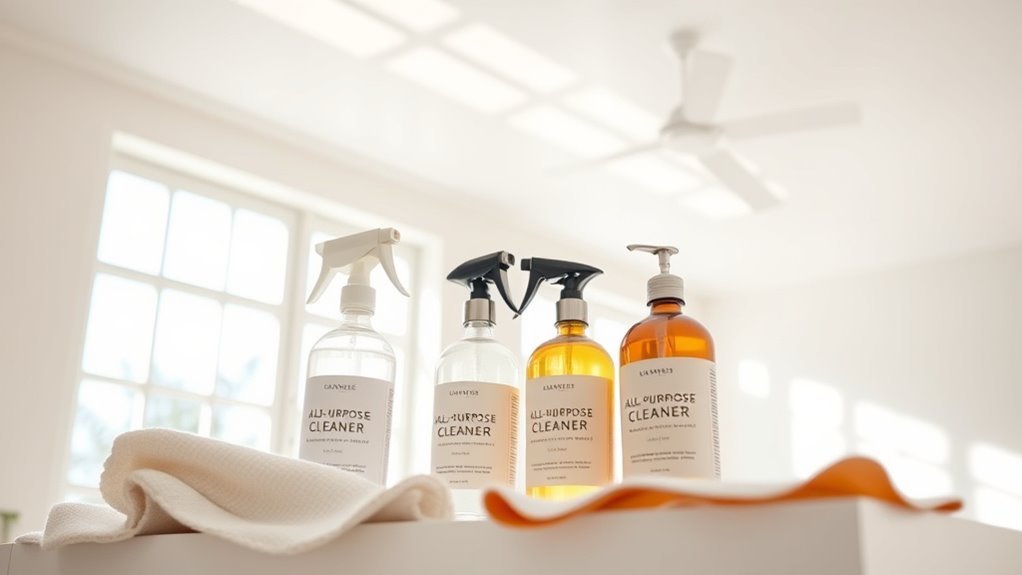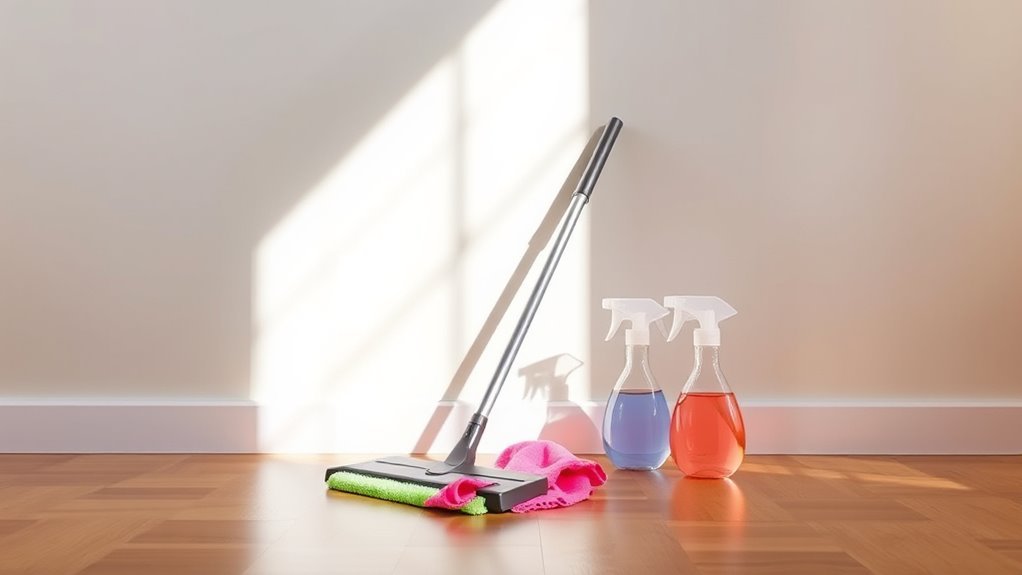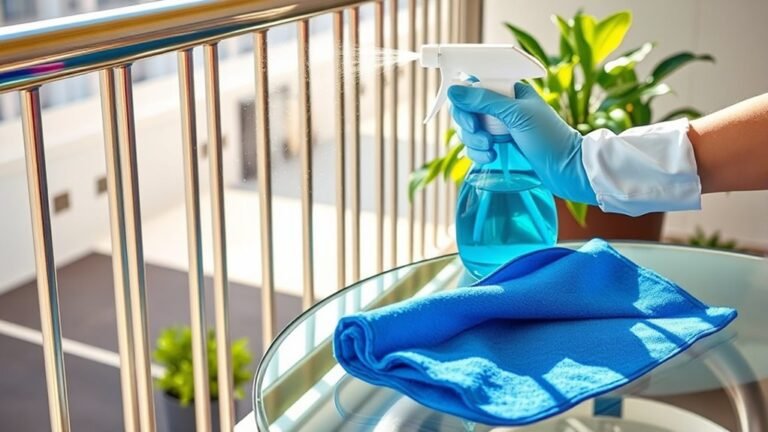Best Products to Clean Your Ceilings
To clean your ceilings effectively, use gentle all-purpose or eco-friendly cleaners that won’t harm finishes. Grab microfiber cloths and extendable dusters for easy dust removal, especially on high ceilings. For kitchen areas, mild degreasers work well on grease, while stain removers keep painted surfaces fresh. Steam cleaners offer deep cleaning without harsh chemicals. Don’t forget protective gloves and spot cleaning sprays for quick fixes. Keep going to discover more tips and tools to keep your ceilings spotless.
Gentle All-Purpose Cleaners for Ceilings

Although ceilings don’t get as dirty as other surfaces, they still need cleaning from time to time. You want a product that respects your ceiling’s finish while effectively removing dust and grime. Gentle formulations are key—they clean without harsh chemicals that could damage paint or texture. When picking a cleaner, always check for surface compatibility to guarantee it won’t cause discoloration or peeling. Using a gentle all-purpose cleaner designed for ceilings lets you maintain a fresh look without risking harm. This way, you keep your space feeling open and free, without worrying about harsh residues or scrubbing damage. Choosing the right cleaner means you can enjoy a cleaner ceiling effortlessly, preserving both your freedom and your home’s beauty.
Microfiber Cloths and Dusting Tools
When tackling ceiling cleaning, microfiber cloths and dusting tools are your best allies for removing dust without causing damage. You’ll love the microfiber benefits—they attract and trap dust particles effortlessly, leaving your ceiling spotless and scratch-free. Unlike traditional cloths, microfiber doesn’t just move dust around; it locks it in, making your cleaning more effective and freeing you from repeated wiping. Mastering simple dusting techniques, like gentle sweeping motions and working in sections, guarantees no spot is missed. Plus, these tools are lightweight and easy to handle, giving you the freedom to clean ceilings without strain. With microfiber cloths and dusting tools in your arsenal, you’ll breeze through ceiling cleaning while preserving their finish and enjoying a dust-free home.
Extendable Dusters for High Ceilings

When you’re tackling high ceilings, an extendable duster can make the job much easier thanks to its adjustable length. These dusters are usually made from lightweight materials, so you won’t strain your arms while reaching up. Plus, they’re designed to trap dust efficiently, helping you clean thoroughly without a mess.
Adjustable Length Benefits
Since reaching high ceilings can be tricky, having an extendable duster with adjustable length makes the job much easier. You’ll appreciate how adjustable tools offer you the freedom to clean spaces at various heights without strain or the need for ladders. By customizing the cleaning height, you control exactly how far your duster extends, making it perfect for ceilings, fans, or even tall shelves. This flexibility means you’re not limited by fixed-length tools that force awkward angles or multiple trips. Plus, when you’re done, these dusters collapse for easy storage. With adjustable length, you’re empowered to tackle cleaning tasks swiftly and safely, giving you more freedom to focus on what matters—not wrestling with your tools. It’s smart, simple, and designed to fit your cleaning needs.
Lightweight Materials Used
Adjustable length dusters are great, but their effectiveness depends a lot on the materials used. When cleaning high ceilings, you want lightweight materials that won’t tire your arm but still adapt well to various ceiling textures. Materials like microfiber and soft feathers can glide over smooth or textured surfaces without damage. Here’s a quick look at common lightweight materials in extendable dusters:
| Material | Best For Ceiling Textures |
|---|---|
| Microfiber | Smooth, lightly textured |
| Ostrich Feathers | Delicate, intricate textures |
| Synthetic Fibers | Rough, popcorn ceilings |
| Cotton Blend | Versatile, medium textures |
| Foam | Flat, smooth surfaces |
Choosing the right material lets you move freely and clean confidently without sacrificing comfort or quality.
Dust Removal Efficiency
Although reaching high ceilings can be challenging, using the right extendable duster can make dust removal much more efficient. You’ll enjoy the freedom to clean without ladders or help, tackling dust accumulation with ease. To maximize dust removal efficiency, consider these key points:
- Length and Reach: Choose a duster that extends enough to access your tallest ceilings comfortably.
- Material Quality: Opt for microfiber or electrostatic heads that attract and hold dust rather than just moving it around.
- Cleaning Frequency: Regularly using your extendable duster prevents heavy dust buildup, making each cleaning quicker and more effective.
Mild Degreasers for Kitchen Ceilings

When tackling grease on your kitchen ceiling, choosing a mild degreaser with safe ingredients is key to protecting your surfaces. You’ll want to apply it carefully, usually with a soft cloth or sponge, to avoid damage while maximizing grease removal. These products are designed to break down buildup effectively without harsh chemicals that could harm your ceiling.
Safe Ingredients Overview
Since kitchen ceilings often accumulate grease without heavy grime, you’ll want cleaning products that use mild degreasers with safe ingredients. Choosing options with natural cleaning agents guarantees you’re protecting both your home and health, while maintaining chemical safety. Here are three key ingredients to look for:
- Citrus-Based Extracts – These naturally break down grease without harsh chemicals.
- Plant-Derived Surfactants – Effective at lifting dirt gently, keeping your ceiling safe.
- Vinegar Solutions – A simple, non-toxic degreaser that’s easy to rinse off.
Application Techniques
Before you start cleaning your kitchen ceiling with mild degreasers, it’s important to prep the area properly to avoid streaks and damage. Use a soft cloth or sponge, and always test a small patch first. Stick to gentle, circular motions to lift grime without harming your ceiling’s finish. Consistent cleaning frequency helps keep ceiling maintenance manageable and prevents buildup. Here’s a quick guide to applying mild degreasers effectively:
| Step | Action | Tip |
|---|---|---|
| 1 | Prepare surface | Dust ceiling before cleaning |
| 2 | Dilute degreaser | Follow product instructions |
| 3 | Apply with sponge | Avoid soaking the ceiling |
| 4 | Rinse & dry thoroughly | Use a microfiber cloth |
This approach keeps your kitchen ceiling fresh while giving you freedom from tough grease worries.
Effectiveness on Grease
Grease buildup on kitchen ceilings can be stubborn, but mild degreasers offer a practical solution for regular cleaning. When choosing cleaning agents, you want something effective yet gentle enough to protect your ceiling’s finish. Mild degreasers excel in grease removal without harsh chemicals that limit your freedom to maintain your space safely. Here’s why they work well:
- They break down grease molecules efficiently, making cleanup easier.
- Their gentle formulas prevent damage or discoloration, preserving your ceiling’s look.
- They’re typically safe for frequent use, so you can tackle buildup before it becomes overwhelming.
Stain Removers Safe for Painted Surfaces
When tackling stains on painted ceilings, choosing the right remover is essential to avoid damaging the finish. You want stain removal techniques that effectively lift marks without stripping paint or causing discoloration. Opt for gentle, non-abrasive cleaners designed specifically for painted surfaces to maintain painted surface safety. Test any product on a small, hidden area first to verify it won’t harm the finish. Using a soft sponge or microfiber cloth along with these safe removers helps you control pressure, preventing surface damage. Avoid harsh chemicals like bleach or ammonia, which can degrade paint. By selecting stain removers mindful of painted surface safety and applying proper stain removal techniques, you’ll keep your ceilings clean and vibrant without sacrificing their integrity.
Eco-Friendly Cleaning Solutions
When cleaning your ceilings, choosing products with natural ingredients can protect both your home and the environment. You’ll find many eco-friendly options that are biodegradable, reducing harmful waste. Let’s explore how these green solutions work effectively without harsh chemicals.
Natural Ingredients Benefits
Although you might think natural cleaning products aren’t as effective, they offer powerful benefits for cleaning ceilings without harsh chemicals. When you choose natural cleaning, you embrace freedom from toxic residues and harmful fumes. Here are three key ingredient benefits you’ll appreciate:
- Gentle on Surfaces – Natural ingredients like vinegar and baking soda clean effectively without damaging paint or texture.
- Health-Friendly – You won’t inhale dangerous chemicals, making the process safer for you and your family.
- Environmentally Responsible – These ingredients break down naturally, reducing pollution and waste.
Biodegradable Cleaning Options
Since biodegradable cleaning options break down quickly and safely, they’re an excellent choice for anyone looking to minimize environmental impact while keeping ceilings spotless. You’ll find plant based cleaners especially effective—they’re tough on dirt yet gentle on the planet. Choosing environmentally friendly products means you’re freeing yourself from harsh chemicals and embracing a cleaner, greener home.
| Cleaner Type | Benefits |
|---|---|
| Plant Based Cleaner | Safe, biodegradable |
| Enzyme Cleaner | Breaks down grime |
| Citrus Extract | Natural degreaser |
| Vinegar Solution | Removes stains safely |
| Baking Soda Blend | Gentle abrasive action |
With these options, you maintain your ceilings’ freshness without compromise—your freedom to choose eco-friendly is powerful.
Steam Cleaners for Deep Cleaning
If you want to tackle stubborn dirt and grime on your ceilings, steam cleaners offer a powerful solution. Their steam cleaner benefits include deep cleaning without harsh chemicals, making the process eco-friendly and safe. By using steam cleaning techniques, you can loosen dirt, kill bacteria, and remove allergens effortlessly.
Steam cleaners tackle ceiling grime effectively, offering deep, eco-friendly cleaning without chemicals.
Here’s how to maximize your steam cleaner experience:
- Adjust the steam pressure to suit your ceiling material, avoiding damage.
- Move the nozzle slowly in sections to allow steam to penetrate thoroughly.
- Use attachments designed for ceilings to reach high or textured areas easily.
With these steps, you gain freedom from tough stains and enjoy a fresh, clean ceiling without extra hassle or toxins.
Protective Gloves and Safety Gear
When you’re cleaning ceilings, wearing protective gloves and safety gear is essential to shield your skin and eyes from harsh chemicals, dust, and debris. Taking these safety precautions lets you clean freely without risking irritation or injury. Choosing the right gear boosts your confidence and keeps the process smooth.
| Protective Gear | Purpose |
|---|---|
| Gloves | Protect skin from chemicals |
| Safety Goggles | Shield eyes from splashes |
| Dust Mask | Prevent inhaling dust/particles |
| Long-Sleeve Shirt | Minimize skin exposure |
Spot Cleaning Sprays for Quick Touch-Ups
Although ceilings don’t get dirty as often as walls or floors, you’ll still want spot cleaning sprays on hand to tackle small stains or marks quickly. Using spot cleaning techniques lets you maintain a fresh ceiling without the hassle of full cleanings. For quick touch ups, try these tips:
Keep spot cleaning sprays handy to swiftly remove ceiling stains and maintain freshness without full cleanings.
- Choose a gentle, non-toxic spray that won’t damage paint or texture.
- Apply the spray directly to the stain and let it sit for a minute.
- Wipe gently with a soft cloth or sponge, avoiding harsh scrubbing.
These sprays save time and effort, giving you freedom to focus on what matters most. Keep one nearby for effortless ceiling upkeep and enjoy a cleaner space with minimal fuss.
Ceiling-Specific Cleaning Brushes
Spot cleaning sprays are great for small marks, but tougher grime or dust buildup on ceilings calls for the right tools. You’ll want to choose from various ceiling brush types designed specifically for overhead cleaning. These brushes come in different cleaning brush materials like synthetic fibers, natural bristles, or microfiber, each offering unique benefits. Synthetic fibers are durable and resist water, natural bristles are gentle on delicate surfaces, and microfiber excels at trapping dust. Selecting the right brush gives you freedom to clean efficiently without damaging your ceiling.
| Brush Type | Cleaning Brush Materials | Best For |
|---|---|---|
| Extendable Brush | Synthetic fibers | High ceilings |
| Ceiling Duster | Microfiber | Dust removal |
| Soft Bristle | Natural bristles | Delicate surfaces |
| Sponge Brush | Foam | Stains and spots |
| Rotating Brush | Mixed fibers | Deep grime |
Frequently Asked Questions
How Often Should I Clean My Ceilings to Prevent Dust Buildup?
You should aim for a cleaning frequency of every three to six months to keep dust buildup at bay. Regularly dusting your ceilings helps with dust prevention and keeps your space feeling fresh and open. If you have allergies or pets, you might want to clean more often. Sticking to a routine makes it less of a chore, giving you more freedom to enjoy your home without worrying about dust piling up.
Can Ceiling Cleaning Products Damage Textured or Popcorn Ceilings?
You should be cautious with ceiling cleaning products on textured or popcorn ceilings, as harsh chemicals or excessive scrubbing can damage their delicate surface. For textured ceiling care, stick to gentle, non-abrasive cleaners and soft cloths or sponges. When doing popcorn ceiling maintenance, avoid soaking the area to prevent deterioration. That way, you keep your ceilings looking great without risking damage, giving you the freedom to enjoy a clean, fresh space.
What Is the Best Way to Prepare My Room Before Ceiling Cleaning?
Before you start, think of your room as a blank canvas ready for a fresh masterpiece. To make your ceiling cleaning smooth, begin with proper room preparation: move furniture away, cover floors and belongings with drop cloths, and open windows for ventilation. Gather all your cleaning supplies beforehand to avoid interruptions. This way, you’ll feel free to focus solely on cleaning, turning a chore into a liberating, satisfying task.
Are There Any Health Risks Associated With Cleaning Ceiling Mold?
Yes, mold exposure can pose health risks, especially if you have allergies or respiratory issues. When cleaning ceiling mold, it’s important to take health precautions like wearing gloves, goggles, and a mask to avoid inhaling spores. Make sure the room is well-ventilated to keep fresh air flowing. Taking these steps helps protect your freedom to breathe easy and keep your space safe without worry.
How Do I Remove Ceiling Stains Caused by Water Damage?
Imagine your ceiling as a blank canvas marred by unsightly water stains. To reclaim its pristine look, start with gentle ceiling cleaning techniques—mix equal parts water and white vinegar for water stain removal. Lightly dab the stain, avoiding excess moisture that could worsen damage. For stubborn spots, a baking soda paste can work wonders. With patience and care, you’ll free your ceiling from those stains, restoring its fresh, open feel.






